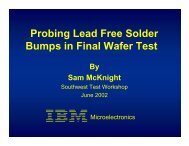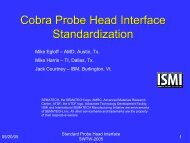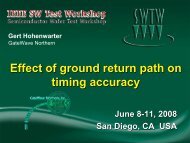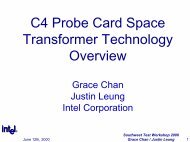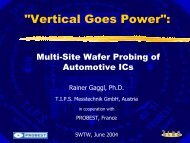Overcoming the Challenges of Parallel RF Test - Semiconductor ...
Overcoming the Challenges of Parallel RF Test - Semiconductor ...
Overcoming the Challenges of Parallel RF Test - Semiconductor ...
Create successful ePaper yourself
Turn your PDF publications into a flip-book with our unique Google optimized e-Paper software.
Roger Hayward<br />
Cascade Microtech<br />
<strong>Overcoming</strong> <strong>the</strong> <strong>Challenges</strong><br />
<strong>of</strong><br />
<strong>Parallel</strong> <strong>RF</strong> <strong>Test</strong><br />
June 8-11, 8<br />
2008<br />
San Diego, CA USA
• The <strong>Challenges</strong><br />
• Roadblocks<br />
Outline<br />
• Clearing <strong>the</strong> Obstacles<br />
• Summary<br />
June 8 to 11, 2008<br />
IEEE SW <strong>Test</strong> Workshop 2
The <strong>Challenges</strong><br />
Decrease <strong>the</strong> cost to wafer-test <strong>RF</strong> devices<br />
• Cost to <strong>Test</strong> one die:<br />
Cost<br />
die<br />
⎛ $<br />
obeCard<br />
f ⎜<br />
Pr + $<br />
⎝ Touchdowns<br />
* t<br />
=<br />
Station <strong>Test</strong><br />
⎞<br />
⎟<br />
⎠<br />
• From this:<br />
– Increase Life <strong>of</strong> Probe card (more touchdowns).<br />
– Minimize <strong>Test</strong> Time.<br />
– <strong>Test</strong> more die per touchdown.<br />
• Setup:<br />
– You have “zero time” to debug <strong>the</strong> test program, after wafers arrive.<br />
• It’s all easy, right?<br />
June 8 to 11, 2008<br />
IEEE SW <strong>Test</strong> Workshop 3
• Known Good Die <strong>RF</strong> <strong>Test</strong>:<br />
The <strong>Challenges</strong><br />
Example: SPDT <strong>RF</strong> Switch<br />
– Confirm Operation.<br />
– Verify:<br />
• Low Insertion Loss (connected path)<br />
• Isolation (disconnected path)<br />
• Linearity (3 rd Harmonic)<br />
• Consider testing in parallel:<br />
– 1 die<br />
.<br />
June 8 to 11, 2008<br />
IEEE SW <strong>Test</strong> Workshop 4
• Known Good Die <strong>RF</strong> <strong>Test</strong>:<br />
The <strong>Challenges</strong><br />
Example: SPDT <strong>RF</strong> Switch<br />
– Confirm Operation.<br />
– Verify:<br />
• Low Insertion Loss (connected path)<br />
• Isolation (disconnected path)<br />
• Linearity (3 rd Harmonic)<br />
• Consider testing in parallel:<br />
– 1 die<br />
Meter<br />
.<br />
<strong>RF</strong> Source<br />
June 8 to 11, 2008<br />
IEEE SW <strong>Test</strong> Workshop 5
• Known Good Die <strong>RF</strong> <strong>Test</strong>:<br />
The <strong>Challenges</strong><br />
Example: SPDT <strong>RF</strong> Switch<br />
– Confirm Operation.<br />
– Verify:<br />
• Low Insertion Loss (connected path)<br />
• Isolation (disconnected path)<br />
• Linearity (3 rd Harmonic)<br />
• Consider testing in parallel:<br />
– 1 die<br />
– 2 die<br />
– 8 die?<br />
<strong>RF</strong> Source<br />
Meter<br />
June 8 to 11, 2008<br />
IEEE SW <strong>Test</strong> Workshop 6
Roadblocks<br />
• <strong>RF</strong> Calibration<br />
• <strong>RF</strong> Isolation<br />
• <strong>Parallel</strong>ism<br />
• Multi-DUT <strong>Test</strong> Program Debug<br />
• Wafer and Prober Availability<br />
June 8 to 11, 2008<br />
IEEE SW <strong>Test</strong> Workshop 7
Roadblock #1<br />
Do you know <strong>the</strong> losses <strong>of</strong> your transmission path?<br />
• <strong>RF</strong> Calibration<br />
• All probes have path loss<br />
– (Some have less than o<strong>the</strong>rs).<br />
• Characterize <strong>the</strong> loss<br />
• Subtract from measurement<br />
June 8 to 11, 2008<br />
IEEE SW <strong>Test</strong> Workshop 8
Roadblock #2<br />
Are you measuring your die or your probe card?<br />
• <strong>RF</strong> Isolation<br />
– Port-to-Port<br />
– Die-to-Die<br />
<strong>RF</strong> Source<br />
Meter<br />
June 8 to 11, 2008<br />
IEEE SW <strong>Test</strong> Workshop 9
Roadblock #2<br />
Are you measuring your die or your probe card?<br />
• <strong>RF</strong> Isolation<br />
– Port-to-Port<br />
– Die-to-Die<br />
<strong>RF</strong> Source<br />
Meter<br />
June 8 to 11, 2008<br />
IEEE SW <strong>Test</strong> Workshop 10
Roadblock #3<br />
Have you fully-optimized your test program?<br />
Time<br />
Insertion<br />
Loss<br />
Isolation<br />
Insertion<br />
Loss<br />
Position 1 Position 2<br />
Isolation<br />
DUT 1<br />
Insertion<br />
Loss<br />
Isolation<br />
Insertion<br />
Loss<br />
Position 1 Position 2<br />
Isolation<br />
DUT 2<br />
Insertion<br />
Loss<br />
Isolation<br />
Insertion<br />
Loss<br />
Position 1 Position 2<br />
Isolation<br />
DUT 3<br />
June 8 to 11, 2008<br />
IEEE SW <strong>Test</strong> Workshop 11
Roadblock #4<br />
Have you fully debugged your probe card?<br />
• How much time do you have to optimize this program?<br />
• How many wafers will you get to use?<br />
• What is broken:<br />
– The silicon?<br />
– The test program?<br />
– The probe card?<br />
June 8 to 11, 2008<br />
IEEE SW <strong>Test</strong> Workshop 12
Clearing <strong>the</strong> Obstacles<br />
• <strong>RF</strong> Calibration:<br />
– Vector<br />
– Scalar<br />
• Direct measurement<br />
• Short-Open<br />
Building your system<br />
• Catering your system for <strong>Parallel</strong> <strong>Test</strong><br />
• <strong>Test</strong> Optimization<br />
June 8 to 11, 2008<br />
IEEE SW <strong>Test</strong> Workshop 13
<strong>RF</strong> Calibration<br />
What is it?<br />
• Probes have electrical loss.<br />
• Measurements include <strong>the</strong> loss.<br />
a 0 b 1<br />
1<br />
Γ m<br />
ED<br />
E R<br />
ES<br />
b 0 a 1<br />
Γ a<br />
• Calibration:<br />
– Characterize <strong>the</strong> transmission path.<br />
– Remove (de-embed) <strong>the</strong> loss from <strong>the</strong><br />
measurements.<br />
Measurement<br />
Probe Loss<br />
E D<br />
: Directivity<br />
E S<br />
: Source Match<br />
E R<br />
: Frequency Tracking<br />
Actual Result<br />
• Scalar Calibration:<br />
– Magnitude loss only.<br />
• Vector Calibration:<br />
– Magnitude and phase.<br />
Γ<br />
m<br />
=<br />
E<br />
D<br />
ERΓa<br />
+<br />
1−<br />
E Γ<br />
S<br />
a<br />
June 8 to 11, 2008<br />
IEEE SW <strong>Test</strong> Workshop 14
• Measure 4 standards:<br />
– Short<br />
– Open<br />
– Load (50 ohms)<br />
– Thru path between ports.<br />
Vector <strong>RF</strong> Calibration<br />
2-port techniques<br />
• Disadvantages:<br />
– Probe standards.<br />
– Standards must match probe topology.<br />
– VNA s<strong>of</strong>tware required.<br />
– Difficult to integrate within an ATE<br />
environment.<br />
– Vector calibration usually not required<br />
for KGD test.<br />
(A)<br />
1ps thru path,<br />
200um length<br />
Shorting bars<br />
50 ohm GSG loads<br />
June 8 to 11, 2008<br />
IEEE SW <strong>Test</strong> Workshop 15
Scalar <strong>RF</strong> Calibration<br />
Simple characterization techniques<br />
• Direct Measurement:<br />
– Use two ports.<br />
– Measure <strong>the</strong> loss, end-to-end.<br />
– Divide loss by 2.<br />
Probe Tips<br />
Length-Matched Thru<br />
• Implementation:<br />
– Length-matched thru.<br />
– Cal-thru.<br />
– On-die thru.<br />
June 8 to 11, 2008<br />
IEEE SW <strong>Test</strong> Workshop 16
Scalar <strong>RF</strong> Calibration<br />
Measure Short-Open to characterize <strong>RF</strong> path loss<br />
• Directivity (E D<br />
) and Source Match (E S<br />
) are generally small.<br />
• Probe Short, Open. Take average.<br />
• Predicted loss is usually within 0.2dB @ 2 GHz<br />
Γ m<br />
a 0 b 1<br />
ED<br />
1<br />
E R<br />
ES<br />
b 0 a 1<br />
Measurement<br />
Probe Loss<br />
Actual Result<br />
Γ<br />
m<br />
=<br />
E<br />
D<br />
ERΓa<br />
+<br />
1−<br />
E Γ<br />
S<br />
a<br />
Γ a<br />
Γ<br />
Γ<br />
m−Open<br />
m−Short<br />
Γ = 1<br />
a<br />
Γ<br />
=<br />
E<br />
=<br />
D<br />
E<br />
ER<br />
+<br />
1−<br />
E<br />
D<br />
−<br />
a =−1<br />
1+<br />
S<br />
;<br />
ER<br />
E<br />
S<br />
E D<br />
↓ 0;<br />
E ↓<br />
S<br />
0;<br />
Γ<br />
m<br />
=<br />
E Γ<br />
R<br />
a<br />
E R<br />
Γ<br />
=<br />
m−Open<br />
− Γ<br />
2<br />
m−Short<br />
June 8 to 11, 2008<br />
IEEE SW <strong>Test</strong> Workshop 17
Scalar <strong>RF</strong> Calibration<br />
Measure Short-Open to characterize <strong>RF</strong> path loss<br />
• Incorporate Shorting path into probe:<br />
June 8 to 11, 2008<br />
IEEE SW <strong>Test</strong> Workshop 18
Clearing <strong>the</strong> Obstacles<br />
Cater your system for <strong>Parallel</strong> test<br />
Time<br />
Insertion<br />
Loss<br />
Isolation<br />
Insertion<br />
Loss<br />
Isolation<br />
Position 1 Position 2<br />
Meter<br />
<strong>RF</strong> Source<br />
June 8 to 11, 2008<br />
IEEE SW <strong>Test</strong> Workshop 19
Clearing <strong>the</strong> Obstacles<br />
Cater your system for <strong>Parallel</strong> test<br />
Time<br />
Insertion<br />
Loss<br />
Isolation<br />
Insertion<br />
Loss<br />
Isolation<br />
Position 1 Position 2<br />
<strong>RF</strong> Source<br />
June 8 to 11, 2008<br />
IEEE SW <strong>Test</strong> Workshop 20
Clearing <strong>the</strong> Obstacles<br />
Cater your system for <strong>Parallel</strong> test<br />
Time<br />
Insertion<br />
Loss<br />
Isolation<br />
Isolation<br />
Insertion<br />
Loss<br />
Position 1 Position 2<br />
<strong>RF</strong> Source<br />
June 8 to 11, 2008<br />
IEEE SW <strong>Test</strong> Workshop 21
Clearing <strong>the</strong> Obstacles<br />
Cater your system for <strong>Parallel</strong> test<br />
Time<br />
Insertion<br />
Loss<br />
Isolation<br />
Isolation<br />
Insertion<br />
Loss<br />
Position 1 Position 2<br />
Insertion<br />
Loss<br />
Isolation<br />
Isolation<br />
Insertion<br />
Loss<br />
Position 1 Position 2<br />
<strong>RF</strong> Source<br />
June 8 to 11, 2008<br />
IEEE SW <strong>Test</strong> Workshop 22
Clearing <strong>the</strong> Obstacles<br />
Cater your system for <strong>Parallel</strong> test<br />
Time<br />
Insertion<br />
Loss<br />
Isolation<br />
Isolation<br />
Insertion<br />
Loss<br />
Position 1 Position 2<br />
Insertion<br />
Loss<br />
Isolation<br />
Isolation<br />
Insertion<br />
Loss<br />
Position 1 Position 2<br />
Reduce Isolation requirements<br />
by testing<br />
at different frequencies.<br />
<strong>RF</strong> Source<br />
<strong>RF</strong> Source<br />
June 8 to 11, 2008<br />
IEEE SW <strong>Test</strong> Workshop 23
Debugging <strong>the</strong> <strong>Test</strong> Program<br />
• Reality Check:<br />
A significant challenge <strong>of</strong> <strong>Parallel</strong> <strong>RF</strong> <strong>Test</strong><br />
– Most devices are not as simple as this<br />
example…<br />
• <strong>Parallel</strong> <strong>Test</strong> Setup:<br />
– Develop test without burning up wafers.<br />
– Develop test with few wafers at a manual<br />
station.<br />
– Optimize test time.<br />
– Assure complete test coverage <strong>of</strong> part.<br />
June 8 to 11, 2008<br />
IEEE SW <strong>Test</strong> Workshop 24
Pyramid Accel Concept<br />
Enabling <strong>Parallel</strong> <strong>RF</strong> <strong>Test</strong><br />
• Design <strong>Test</strong> program.<br />
• Design Probe card.<br />
• Obtain blind-build packaged parts.<br />
• Temporarily eliminate:<br />
– Wafer prober (cost & availability)<br />
– Wafers (develop prior to <strong>the</strong>ir arrival)<br />
Pyramid Probe “Core”<br />
Pyramid Accel Debug Fixture<br />
• <strong>Test</strong> with packaged parts.<br />
• Optimize test program.<br />
June 8 to 11, 2008<br />
IEEE SW <strong>Test</strong> Workshop 25
Pyramid Accel Fixture<br />
June 8 to 11, 2008<br />
IEEE SW <strong>Test</strong> Workshop 26
Pyramid Accel Fixture<br />
Enabling <strong>Parallel</strong> <strong>RF</strong> <strong>Test</strong><br />
• <strong>Test</strong> features:<br />
– Enables test <strong>of</strong> complex probe cards.<br />
– Socket option allows you to replace<br />
blind-build parts.<br />
– Electrical performance similar to<br />
Pyramid Probe performance.<br />
Pyramid Probe Core<br />
• Golden Probe:<br />
– Keep an Accel fixture at <strong>the</strong> production<br />
test site.<br />
– Validate probe card & test program are<br />
still functioning properly.<br />
Pyramid Accel Debug Fixture<br />
June 8 to 11, 2008<br />
IEEE SW <strong>Test</strong> Workshop 27
Summary<br />
<strong>Parallel</strong> <strong>RF</strong> <strong>Test</strong> presents a unique Challenge<br />
• Calibrate <strong>RF</strong> path loss using scalar techniques.<br />
• Characterize port-to-port isolation.<br />
• Design probe card to optimize for parallel test.<br />
• Write a true parallel-processing test program.<br />
• Optimize your test program as early as<br />
possible.<br />
– Assure adequate test coverage.<br />
– Lower your test cost per die.<br />
June 8 to 11, 2008<br />
IEEE SW <strong>Test</strong> Workshop 28
Summary<br />
Thank You!<br />
June 8 to 11, 2008<br />
IEEE SW <strong>Test</strong> Workshop 29


